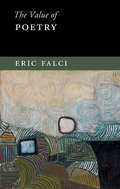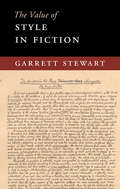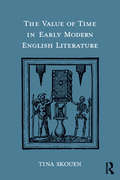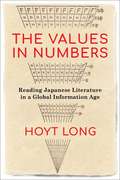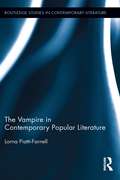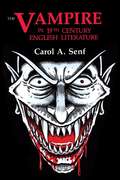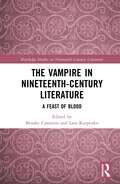- Table View
- List View
The Value of James Joyce
by Margot NorrisMargot Norris' The Value of James Joyce explores the writings of James Joyce from his early poetry and short stories to his final avant-garde work, Finnegans Wake. His works include some of the most difficult and challenging texts in the English literary canon without diminishing his impressive popularity beyond the scope of academia. A democratic impulse may be counted as an important feature of this paradox: that Joyce's stylistic and linguistic experiments never lose their focus on a world of characters whose everyday activities comprise the stories of life in Ireland in the late nineteenth and early twentieth century, even as some of the most famous texts are given structures derived from Ancient Greek literature. The Value of James Joyce examines not only the significance of the ostensibly ordinary but the function of natural and urban spaces, classical and popular culture, and the moods, voice, and language that give Joyce's works their widespread appeal.
The Value of Milton
by John LeonardIn The Value of Milton, leading critic John Leonard explores the writings of John Milton from his early poetry to his major prose. Milton's work includes one of the most difficult and challenging texts in the English literary canon, yet he remains impressively popular with general readers. Leonard demonstrates why Milton has enduring value for our own time, both as a defender of political liberty and as a poet of sublimity and terror who also exhibits moments of genuine humanity and compassion. A poet divided against himself, Milton offers different rewards to different readers. The Value of Milton examines not only the significance of his most celebrated verse but also the function of biblical allegory, classical culture, and the moods, voice and language that give Milton's writings their perennial appeal.
The Value of Poetry (The Value of)
by Eric FalciEric Falci's The Value of Poetry offers an evaluation and critique of the literary, cultural, and political value of poetry in the twenty-first century. Falci claims that some of the most vital, significant, and enduring human notions have been voiced and held in poems. Poems marble civilizations: they catch courses of thought, tracks of feeling, and acts of speech and embed these shapes in language that is, in some fashion, poised toward the future. Falci argues that poetry is a vital medium in addressing and understanding some of the most pressing issues of our time. Ranging widely across canonical and contemporary poetry, The Value of Poetry shows how poems matter, and what poetry offers to readers in the contemporary world.
The Value of Style in Fiction (The Value of)
by Garrett StewartThis is the first book to demonstrate the value of prose analysis - both appreciative and interpretive in its 'evaluations' - across dozens of authors, including Jane Austen, Virginia Woolf, Don DeLillo, and Toni Morrison. The Value of Style in Fiction is designed not just for students and scholars of the English novel - and its verbal 'microplots' - but also for anyone interested in mastering the art of the sentence by 'writing along with' its finest examplars in a fully descriptive account: a stylistic challenge in its own right exemplified by Stewart's multifaceted critical modelling. Beginning with a state-of-the-field survey of prose poetics, this manual of invested reading concludes with an 'Inventory' of terms (bolded throughout) drawn primarily from grammar, rhetoric, etymology, and phonetics, but also narratology and poetic theory: a glossary whose consultation can help cross-map certain verbal tendencies in literary-historical evolution and its separate landmark writers.
The Value of Time in Early Modern English Literature
by Tina SkouenThe stigma of haste pervaded early modern English culture, more so than the so-called stigma of print. The period’s writers were perpetually short on time, but what does it mean for authors to present themselves as hasty or slow, or to characterize others similarly? This book argues that such classifications were a way to define literary value. To be hasty was, in a sense, to be irresponsible, but, in another sense, it signaled a necessary practicality. Expressions of haste revealed a deep conflict between the ideal of slow writing in classical and humanist rhetoric and the sometimes grim reality of fast printing. Indeed, the history of print is a history of haste, which carries with it a particular set of modern anxieties that are difficult to understand in the absence of an interdisciplinary approach. Many previous studies have concentrated on the period’s competing definitions of time and on the obsession with how to use time well. Other studies have considered time as a notable literary theme. This book is the first to connect ideas of time to writerly haste in a richly interdisciplinary manner, drawing upon rhetorical theory, book history, poetics, religious studies and early modern moral philosophy, which, only when taken together, provide a genuinely deep understanding of why the stigma of haste so preoccupied the early modern mind. The Value of Time in Early Modern English Literature surveys the period from ca 1580 to ca 1730, with special emphasis on the seventeenth century. The material discussed is found in emblem books, devotional literature, philosophical works, and collections of poetry, drama and romance. Among classical sources, Horace and Quintilian are especially important. The main authors considered are: Robert Parsons; Edmund Bunny; King James 1; Henry Peacham; Thomas Nash; Robert Greene; Ben Jonson; Margaret Cavendish; John Dryden; Richard Baxter; Jonathan Swift; Alexander Pope. By studying these writers’ expressions of time and haste, we may gain a better understanding of how authorship was defined at a time when the book industry was gradually taking the place of classical rhetoric in regulating writers’ activities.
The Value of Virginia Woolf
by Madelyn DetloffIn The Value of Virginia Woolf, Madelyn Detloff explores the writings of Virginia Woolf from her early texts to her challenging and inventive novels. Detloff demonstrates why Woolf has enduring value for our own time, both as a defender of modernist experimentation and as a novelist of innovation and poetic vision who also exhibits moments of intense insight and philosophical depth. A famously enigmatic figure, Woolf's literary works offer different rewards to different readers. The Value of Virginia Woolf examines not only the significance of her most celebrated fiction but the function of time and allegory, natural and urban spaces, voice and language that give Woolf's writings their perennial appeal.
The Value of the Novel
by Peter BoxallPeter Boxall's The Value of the Novel offers a reappraisal of the ethical, political and literary value of the novel as a genre at turning point in the history both of literature and of criticism. As the dominant critical concerns of the twentieth century faded, and new cultural and technological environments emerged, Boxall argues that we lost our collective sense of the purpose of the novel. This book responds to this predicament by demonstrating why and how the novel matters to us today. Ranging from Daniel Defoe to Zadie Smith, Boxall shows how the formal properties of the novel allow us to imagine the worlds in which we live. This is a vibrant, compelling and richly informed critical perspective that asks us to see anew how central fiction is to our idea of the world, and how richly the novel informs our attempts to understand our present and our future.
The Values in Numbers: Reading Japanese Literature in a Global Information Age
by Hoyt LongIdeas about how to study and understand cultural history—particularly literature—are rapidly changing as new digital archives and tools for searching them become available. This is not the first information age, however, to challenge ideas about how and why we value literature and the role numbers might play in this process. The Values in Numbers tells the longer history of this evolving global conversation from the perspective of Japan and maps its potential futures for the study of Japanese literature and world literature more broadly.Hoyt Long offers both a reinterpretation of modern Japanese literature through computational methods and an introduction to the history, theory, and practice of looking at literature through numbers. He weaves explanations of these methods and their application to literature together with critical reflection on the kinds of reasoning such methodologies facilitate. Chapters guide readers through increasingly complex techniques while making novel arguments about topics of fundamental concern, including the role of quantitative thinking in Japanese literary criticism; the canonization of modern literature in print and digital media; the rise of psychological fiction as a genre; the transnational circulation of modernist forms; and discourses of race under empire. Long models how computational methods can be applied outside English-language contexts and to languages written in non-Latin scripts. Drawing from fields as diverse as the history of science, book history, world literature, and critical race theory, this book demonstrates the value of numbers in literary study and the values literary critics can bring to the reading of difference in numbers.
The Values of Literary Studies
by Rónán McdonaldWhat is valuable about literary studies? What is its point and purpose? In The Values of Literary Studies: Critical Institutions, Scholarly Agendas, leading scholars in the field illuminate both the purpose and priorities of literary criticism. At a time when the humanities are increasingly called upon to justify themselves, this book seeks to clarify their myriad values and ideologies. Engaging the idea of literary value while at the same time remaining attuned to aesthetic, ethical, political and psychological principles, this book serves to underscore the enduring significance of literary studies in an academic climate that is ostensibly concerned with expediency and quantification. As a sophisticated examination of literary theory and criticism, The Values of Literary Studies: Critical Institutions, Scholarly Agendas provides a comprehensive and hopeful view of where the discipline is now and what avenues it is likely to take from here.
The Vampire in Contemporary Popular Literature (Routledge Studies in Contemporary Literature)
by Lorna Piatti-FarnellProminent examples from contemporary vampire literature expose a desire to re-evaluate and re-work the long-standing, folkloristic interpretation of the vampire as the immortal undead. This book explores the "new vampire" as a literary trope, offering a comprehensive critical analysis of vampires in contemporary popular literature and demonstrating how they engage with essential cultural preoccupations, anxieties, and desires. Drawing from cultural materialism, anthropology, psychoanalysis, literary criticism, gender studies, and postmodern thought, Piatti-Farnell re-frames the concept of the vampire in relation to a distinctly twenty-first century brand of Gothic imagination, highlighting important aesthetic, conceptual, and cultural changes that have affected the literary genre in the post-2000 era. She places the contemporary literary vampire within the wider popular culture scope, also building critical connections with issues of fandom and readership. In reworking the formulaic elements of the vampiric tradition — and experimenting with genre-bending techniques — this book shows how authors such as J.R. Ward, Stephanie Meyers, Charlaine Harris, and Anne Rice have allowed vampires to be moulded into enigmatic figures who sustain a vivid conceptual debt to contemporary consumer and popular culture. This book highlights the changes — conceptual, political and aesthetic — that vampires have undergone in the past decade, simultaneously addressing how these changes in "vampire identity" impact on the definition of the Gothic as a whole.
The Vampire in Nineteenth-Century English Literature
by Carol A. SenfCarol A. Senf traces the vampire’s evolution from folklore to twentieth-century popular culture and explains why this creature became such an important metaphor in Victorian England. This bloodsucker who had stalked the folklore of almost every culture became the property of serious artists and thinkers in Victorian England, including Charlotte and Emily Brontë, George Eliot, Charles Dickens, Karl Marx, and Friedrich Engels. People who did not believe in the existence of vampires nonetheless saw numerous metaphoric possibilities in a creature from the past that exerted pressure on the present and was often threatening because of its sexuality.
The Vampire in Nineteenth-Century Literature: A Feast of Blood (Routledge Studies in Nineteenth Century Literature)
by Brooke CameronAgainst the social and economic upheavals that characterized the nineteenth century, the border-bending nosferatu embodied the period’s fears as well as its forbidden desires. This volume looks at both the range among and legacy of vampires in the nineteenth century, including race, culture, social upheaval, gender and sexuality, new knowledge and technology. The figure increased in popularity throughout the century and reached its climax in Dracula (1897), the most famous story of bloodsuckers. This book includes chapters on Bram Stoker’s iconic novel, as well as touchstone texts like John William Polidori’s The Vampyre (1819) and Sheridan Le Fanu’s Carmilla (1872), but it also focuses on the many “Other” vampire stories of the period. Topics discussed include: the long-war veteran and aristocratic vampire in Varney; the vampire as addict in fiction by George MacDonald; time discipline in Eric Stenbock’s Studies of Death; fragile female vampires in works by Eliza Lynn Linton; the gender and sexual contract in Mary Elizabeth Braddon’s “Good Lady Ducayne;” cultural appropriation in Richard Burton’s Vikram and the Vampire; as well as Caribbean vampires and the racialized Other in Florence Marryat’s The Blood of the Vampire. While drawing attention to oft-overlooked stories, this study ultimately highlights the vampire as a cultural shape-shifter whose role as “Other” tells us much about Victorian culture and readers’ fears or desires.
The Vampire: A New History
by Nick GroomAn authoritative new history of the vampire, two hundred years after it first appeared on the literary scene Published to mark the bicentenary of John Polidori’s publication of The Vampyre, Nick Groom’s detailed new account illuminates the complex history of the iconic creature. The vampire first came to public prominence in the early eighteenth century, when Enlightenment science collided with Eastern European folklore and apparently verified outbreaks of vampirism, capturing the attention of medical researchers, political commentators, social theorists, theologians, and philosophers. Groom accordingly traces the vampire from its role as a monster embodying humankind’s fears, to that of an unlikely hero for the marginalized and excluded in the twenty-first century. Drawing on literary and artistic representations, as well as medical, forensic, empirical, and sociopolitical perspectives, this rich and eerie history presents the vampire as a strikingly complex being that has been used to express the traumas and contradictions of the human condition.
The Van and the Hot Rod (Primary Phonics Storybook #Set 1A Book 3)
by Barbara W. MakarA systematic, phonics-based early reading program that includes: the most practice for every skill, decodable readers for every skill, and reinforcement materials--help struggling students succeed in the regular classroom
The Vanished Settlers of Greenland: In Search of a Legend and Its Legacy
by Robert RixFor four hundred years, Norse settlers battled to make southern Greenland a new, sustainable home. They strove against gales and winter cold, food shortages and in the end a shifting climate. The remnants they left behind speak of their determination to wrest an existence at the foot of this vast, icy and challenging wilderness. Yet finally, seemingly suddenly, they vanished; and their mysterious disappearance in the fifteenth century has posed a riddle to scholars ever since. What happened to the lost Viking colonists? For centuries people assumed their descendants could still be living, so expeditions went to find them: to no avail. Robert Rix tells the gripping story of the missing pioneers, placing their poignant history in the context of cultural discourse and imperial politics. Ranging across fiction, poetry, navigation, reception and tales of exploration, he expertly delves into one of the most contested questions in the annals of colonization.
The Vanishing World of The Islandman: Narrative and Nostalgia (Palgrave Studies in Literary Anthropology)
by Máiréad Nic CraithExploring An t-Oileánach (anglicised as The Islandman), an indigenous Irish-language memoir written by Tomás Ó Criomhthain (Tomás O'Crohan), Máiréad Nic Craith charts the development of Ó Criomhthain as an author; the writing, illustration, and publication of the memoir in Irish; and the reaction to its portrayal of an authentic, Gaelic lifestyle in Ireland. As she probes the appeal of an island fisherman’s century-old life-story to readers in several languages—considering the memoir’s global reception in human, literary and artistic terms—Nic Craith uncovers the indelible marks of Ó Criomhthain’s writing closer to home: the Blasket Island Interpretive Centre, which seeks to institutionalize the experience evoked by the memoir, and a widespread writerly habit amongst the diasporic population of the Island. Through the overlapping frames of literary analysis, archival work, interviews, and ethnographic examination, nostalgia emerges and re-emerges as a central theme, expressed in different ways by the young Irish state, by Irish-American descendants of Blasket Islanders in the US today, by anthropologists, and beyond.
The Vanishing of Carolyn Wells
by Rebecca Rego BarryThe Vanishing of Carolyn Wells is the first biography of one of the &“lost ladies&” of detective fiction who wrote more than eighty mysteries and hundreds of other works between the 1890s and the 1940s.Carolyn Wells (1862–1942) excelled at writing country house and locked-room mysteries for a decade before Agatha Christie entered the scene. In the 1920s, when she was churning out three or more books annually, she was dubbed &“about the biggest thing in mystery novels in the US.&”On top of that, Wells wielded her pen in just about every literary genre, producing several immensely popular children&’s books and young adult novels; beloved anthologies; and countless stories, prose, and poetry for magazines such as Thrilling Detective, Life, The Saturday Evening Post, Harper&’s, and The New Yorker. All told, Wells wrote over 180 books. Some were adapted into silent films, and some became bestsellers. Yet a hundred years later, she has been all but erased from literary history. Why? How?This investigation takes us on a journey to Rahway, New Jersey, where Wells was born and is buried; to New York City&’s Upper West Side, where she spent her final twenty-five years; to the Library of Congress, where Carolyn&’s world-class collection of rare books now resides; and to many other public and private collections where exciting discoveries unfolded.Part biography and part sleuthing narrative, The Vanishing of Carolyn Wells recovers the life and work of a brilliant writer who was considered one of the funniest, most talented women of her time.
The Variation Theory of Comparative Literature
by Shunqing CaoSeeing the restrictions of former studies in Comparative Literature and aiming to amend these deficiencies, the author of this book mainly discusses the major theoretical significance and academic value of the Variation Theory in the whole process of the development of Comparative Literature in the world. In China the seminal comparative study of literature among different cultures can be dated back to ancient China, while the founding of comparative literature as a distinct academic discipline has to be largely owing to the influence of the West. The modern Chinese study of comparative literature formed its uniqueness under Western influence. The direct influence of the translation of western theories into China is remarkable. However, in the course of translation and reception of Western theories, Chinese comparatists and intellectuals have been encountering various problems, and solving them with an alternative method accordingly different from the traditional methods proposed by the French School and the American School. Therefore, in this book, modern Chinese study of comparative literature is put in a historical context with regard to the theoretical issue of the discipline in China through the entire 20th century. At present, many scholars in China and in other countries agree that, with the influence study proposed by the French School and the study of analogy advocated by the American School, the entire theoretical system of Comparative Literature is well built. However, when the comparative study of literature between East and West is concerned, the theory of Comparative Literature is far from perfect. It is not only because many problems still exist, but there are significant defects in their theoretical bases respectively. Many researches have proven that even with the influence study and the study of analogy, we still can not solve many problems in the practice of studies in comparative literature. This does not mean that we have no respect for the contributions of the French School and the American School; we just want to attach importance to literary variations, which is a phenomenon that has long been neglected. The purpose of putting forward the Variation Theory in Comparative Literature is to provide new perspectives, new methods and new theory to the study of comparative literature, which may be a major breakthrough in the international arena of Comparative Literature. The neglect of literary variation is mainly because all the previous theories about comparative literature start off in search of similarities but not differences. Accordingly, in 1990s heterogeneity as a premise of comparability was put forward. And later, the variation theory was further advanced. It is not only the important phenomenon in literary communication, but also the most valuable research object in Comparative Literature. Still, it will be an important path to cultural innovation. The Variation Theory may make up the major flaws of theories by both French school and the American School since it focus on heterogeneity and variability in cross-cultural literary events, especially the ones of inter-civilization which will be a new course for comparative literature. Throughout the history of literature and the history of literary communication, collisions between different civilizations have always been producing new literary events which make the heterogeneity of different civilizations and variability traceable. The higher stage of literary communication may mean dialogue and blend between different cultures. The overarching concerns of this book include different levels of variation in literary communication and the studies of different objects. The introduction begins with a literature review of major achievements made by the French School and the American School with pointing out what they have neglected. The body of the book is divided into three parts. In the first part, Chapter 1 deals with the major contributions of influence study and its weaknesses. The origination of comparative literature i...
The Varieties of Authorial Intention
by John FarrellThis book explores the logic and historical origins of a strange taboo that has haunted literary critics since the 1940s, keeping them from referring to the intentions of authors without apology. The taboo was enforced by a seminal article, "The Intentional Fallacy," and it deepened during the era of poststructuralist theory. Even now, when the vocabulary of "critique" that has dominated the literary field is under sweeping revision, the matter of authorial intention has yet to be reconsidered. This work explains how "The Intentional Fallacy" confused different kinds of authorial intentions and how literary critics can benefit from a more up-to-date understanding of intentionality in language. The result is a challenging inventory of the resources of literary theory, including implied readers, poetic speakers, omniscient narrators, interpretive communities, linguistic indeterminacy, unconscious meaning, literary value, and the nature of literature itself.
The Varieties of Metaphysical Poetry
by T. S. EliotThe famed series of Trinity College and Johns Hopkins lectures in which the Nobel Prize winner explored history, poetry, and philosophy. While a student at Harvard in the early years of the twentieth century, T. S. Eliot immersed himself in the verse of Dante, Donne, and the nineteenth-century French poet Jules Laforgue. His study of the relation of thought and feeling in these poets led Eliot, as a poet and critic living in London, to formulate an original theory of the poetry generally termed &“metaphysical&”—philosophical and intellectual poetry that revels in startlingly unconventional imagery. Eliot came to perceive a gradual &“disintegration of the intellect&” following three &“metaphysical moments&” of European civilization—the thirteenth, seventeenth, and nineteenth centuries. The theory is at once a provocative prism through which to view Western intellectual and literary history and an exceptional insight into Eliot&’s own intellectual development. This annotated edition includes the eight Clark Lectures on metaphysical poetry that Eliot delivered at Trinity College in Cambridge in 1926, and their revision and extension for his three Turnbull Lectures at Johns Hopkins University in Baltimore in 1933. They reveal in great depth the historical currents of poetry and philosophy that shaped Eliot&’s own metaphysical moment in the twentieth century.
The Varieties of Temporal Experience: Travels in Philosophical, Historical, and Ethnographic Time
by Professor Michael D. JacksonWhat does it mean to live in time, between the unforeseeable and the irreversible? In The Varieties of Temporal Experience, Michael Jackson demonstrates the significance of a phenomenology of time for ethnography, philosophy, and history through a multifaceted consideration of the gap between our cultural representations of temporality and the bewildering multiplicity of our experience of being-in-time.Jackson explores temporality in a subjective mode as a form of literary anthropology. The first part of the book tells the story of John Joseph Pawelka, whose 1910 escape from prison and subsequent disappearance became one of New Zealand’s great unsolved mysteries, discussing what it reveals about the interplay of popular stories, hidden histories, and media narratives in constructing allegories of national and moral identity. In the second, Jackson reflects on journeys up and down the islands of New Zealand, touching on the ways that personal stories are interwoven with social and historical events. Throughout this groundbreaking book, Jackson juxtaposes philosophy, history, and ethnography in an attempt to do justice to the extraordinary variety of temporal experience, at the same time exploring the ethical and existential quandaries that arise from the complexity of lived time.
The Variorum Edition of the Poetry of John Donne, Volume 4.2: The Songs and Sonets (The\variorum Edition Of The Poetry Of John Donne Ser.)
by John DonneThis volume, the ninth in the series of The Variorum Edition of the Poetry of John Donne, presents newly edited critical texts of 25 love lyrics. Based on an exhaustive study of the manuscripts and printed editions in which these poems have appeared, Volume 4.2 details the genealogical history of each poem, accompanied by a thorough prose discussion, as well as a General Textual Introduction of the Songs and Sonets collectively. The volume also presents a comprehensive digest of the commentary on these Songs and Sonets from Donne's time through 1999. Arranged chronologically within sections, the material for each poem is organized under various headings that complement the volume's companions, Volume 4.1 and Volume 4.3.
The Vast Design: Patterns in W.B. Yeats's Aesthetic
by Edward EngelbergIn recent years Yeats has been receiving a great deal of critical attention from many aspects. Professor Engelberg here makes a distinctive contribution to the new studies by bringing under discussion the kind of aesthetic views developed by Yeats in order to rationalize his own practice as poet and dramatist. Yeats was pragmatic in his approach and therefore not concerned about formulating a tight critical theory. Recognizing this, the author at the same time skilfully guides the reader through the opinions expressed in the critical essays to meaningful patterns and shows how Yeats's aesthetic views developed, often in relation to his study of Balzac, Blake, Spenser, Shelley, Morris, and the Irish theatre of his own day. Throughout the stress is fittingly on the originality of Yeats, and the reader will be impressed always with his great critical perceptiveness.
The Vegetable Alphabet Book (Jerry Pallotta's Alphabet Books)
by Jerry Pallotta Bob ThomsonA wonderful blend of facts and humor makes learning about vegetable gardening fun and easy. Learn about fiddleheads, munchkin pumpkins, snow peas, walla wallas, and more!Beautiful color illustrations lead children through a brief introduction to soil preparation and seed planting, as well as through a discovery of both common and exotic vegetables.
The Veggiecational Book: A Book About Numbers, Colors, Shapes And Letters! (VeggieTales)
by Phil VischerThe Veggiecational Book from Big Idea's "VeggieTales" cast of characters. This 4-in-1 volume includes the full text of Bob & Larry's ABC's, How Many Veggies?, Pa Grape's Shapes, and Junior's Colors.

